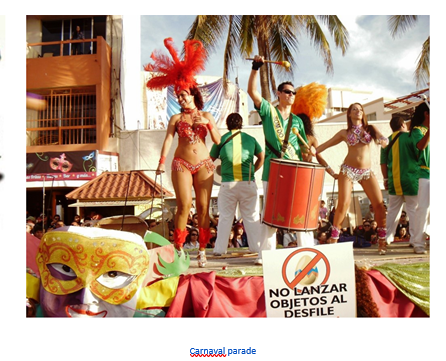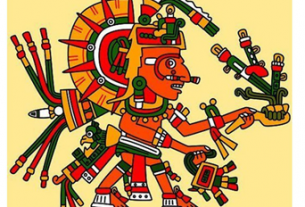By Dan and Liza Goy on the July 2020 Edition
La Paz is our favourite city anywhere on Baja as it still retains much of its original colonial identity and Mexican culture. Although much has changed since our first Mexican adventure in 1985, La Paz continues to maintain an old-world charm for us. In 1985, we stayed at the Oasis RV Park in Centenario, on the beach, 20 minutes north of town on Hwy 1. Back in the day, there were no fewer than four RV parks in La Paz, in addition to Oasis, Casa Blanca RV Park, El Cardon RV Park, La Paz Trailer Park and Aquamarina RV Park. Oasis, El Cardon and La Paz have been closed for many years. We did stay at Casa Blanca before it closed in 2007. Aquamarina closed, then reopened, and we believe it has now closed again.
 Fortunately, Campestre Maranatha opened up to the public al-most 20 years ago and expanded their RV Park to accommo-date caravans. Campestre Maranatha is a Christian campground founded by Cecil and Faye Byers. The site of this campground is the former runway where they first landed their Cessna air-plane as missionaries. This is a functioning bible camp, mostly attended by local children on weekends. It is an excellent RV Park with great showers and washrooms, a pool (unheated),good Wi-Fi. A granddaughter operates a coffee shop on the corner of the property. The coffee shop offers great cinnamon buns, coffee, a breakfast special and great Wi-Fi.
Fortunately, Campestre Maranatha opened up to the public al-most 20 years ago and expanded their RV Park to accommo-date caravans. Campestre Maranatha is a Christian campground founded by Cecil and Faye Byers. The site of this campground is the former runway where they first landed their Cessna air-plane as missionaries. This is a functioning bible camp, mostly attended by local children on weekends. It is an excellent RV Park with great showers and washrooms, a pool (unheated),good Wi-Fi. A granddaughter operates a coffee shop on the corner of the property. The coffee shop offers great cinnamon buns, coffee, a breakfast special and great Wi-Fi.
A couple of large grocery stores are located at the entrance to La Paz, very handy for RVs looking for groceries, easy in and easy out. We have a couple of favourite eateries; Los Magueyes Restaurant (corner of Ignacio Allende entre Ramirez and Guillermo Prieto) and a hot dog/hamburger stand located (16 de Septiembre and Belisario Dominguez). With almost 1200 places to eat in La Paz, that says something, for sure. There is so much to do and see in La Paz, it is hard to say where to start.
 Eco-tourism is the major source of tourism income as people come to enjoy its marine wonders, as well as its diverse, and often unique, terrestrial species endemic to the region. There are some 900 islands and inlets in the Gulf of California, with 244 now under UNESCO protection as World Heritage Bio-Reserves.
Eco-tourism is the major source of tourism income as people come to enjoy its marine wonders, as well as its diverse, and often unique, terrestrial species endemic to the region. There are some 900 islands and inlets in the Gulf of California, with 244 now under UNESCO protection as World Heritage Bio-Reserves.
The Espiritu Santos Islands group, which borders the southeast-ern portion of the Bay of La Paz and are considered the crown jewels of the islands of the Gulf (also referred to as the Sea of Cortez/Mar de Cortés) are the primary tourist destination of the area. Its diving, snorkeling and kayaking are considered second to none. You can arrange to swim with whale sharks and sea lions downtown on the malecón from many operators.
Malecón (beach boulevard) Alvaro Obregón
Along this five kilometre malecón, you will find restaurants, ho-tels, night clubs, bars and specialty stores. You can take a relaxing walk on its wide and well-illuminated sidewalks, or just simply enjoy its reddish sunsets that include live music on the weekends. We recommend stopping for lunch at our favourite hot dog stand. You can see El Mogote, a small peninsula, the cruise ship port and a series of bronze sculptures including one of the most outstanding, El Cristo de Mar.
Plaza Constitución (Jardín Velazco)
La Paz’s tidy downtown zócalo (town square) is enclosed by Avenida Independencia and Calles 5 de Mayo, Revolución de 1910 and Madero. At the southwest side of the plaza is the post-missionary style Catedral de Nuestra Señora de La Paz that replaced the original mission church in 1861. Architectural beauty, surrounded by old buildings, where the Paceños (people from La Paz) meet, with its gardens, benches, kiosks and the unique fountain, Hongo de Balandra, makes these gar-dens something special. At the northwest side of Plaza Constitución, opposite the cathedral, is the 1880s era former Casa de Gobierno (Government House), which is now a gallery with rotating exhibits.
Carnaval is an official Mexican holiday that kicks off a five-day celebration before the Catholic lent begins on Ash Wednesday. Beginning the weekend before Lent, Carnaval is celebrated exuberantly with parades, floats, costumes, music and dancing in the streets with the most vigorous celebration taking place over the one weekend. Carnaval is equivalent to Mardi Gras in New Orleans. The festival of Carnaval is celebrated as a last indulgence of carnal pleasures that Catholics must give up for 40 days of fasting during Lent, from Ash Wednesday to Easter Sunday. In fact, the word Carnaval is derived from Latin, mean-ing take away or goodbye to flesh, and strict Catholics will give up meat eating during Lent.
Catedral Nuestra Señora de La Paz
Founded as a mission on December 3, 1720 by the priests Juan de Ugarte and Jaime Bravo, it was abandoned in 1735 due to the hostility of the Indians of that region. In 1871, the current building of the Cathedral was built, with a Latin cross base and covered by a two-sided roof and two pyramidal towers. In the interior, it has a beautiful altar dedicated to the virgin that gives it its name. Although the twin-towered brick edifice looms over the plaza, it lacks the charm of earlier Jesuit mis-sions. Inside, only an image of Nuestra Señora del Pilar and a few theological books survive from the earlier 1720 mission.
 Museo Regional de Antropología e Historia (Regional Museum of Anthropology and History) features valuable archaeological and ethnographic objects and 1200 samples related to thepeninsula’s geological evolution are on display in its modern rooms. You can appreciate fossil remains, rocks with inscriptions, photographs of the rock paintings, books about the missions and regional craftsmanship whilst touring this museum,inaugurated in 1981. It also offers details regarding the extraction of gold and pearls. The museum is located at the Cultural Unit of Agora, between Altamirano and 5 de Mayo Streets.
Museo Regional de Antropología e Historia (Regional Museum of Anthropology and History) features valuable archaeological and ethnographic objects and 1200 samples related to thepeninsula’s geological evolution are on display in its modern rooms. You can appreciate fossil remains, rocks with inscriptions, photographs of the rock paintings, books about the missions and regional craftsmanship whilst touring this museum,inaugurated in 1981. It also offers details regarding the extraction of gold and pearls. The museum is located at the Cultural Unit of Agora, between Altamirano and 5 de Mayo Streets.
Carnaval is an official Mexican holiday that kicks off a five-day celebration before the Catholic lent begins on Ash Wednesday. Beginning the weekend before Lent, Carnaval is celebrated exuberantly with parades, floats, costumes, music and dancing in the streets with the most vigorous celebration taking place over the one weekend. Carnaval is equivalent to Mardi Gras in New Orleans. The festival of Carnaval is celebrated as a last indulgence of carnal pleasures that Catholics must give up for 40 days of fasting during Lent, from Ash Wednesday to Easter Sunday. In fact, the word Carnaval is derived from Latin, meaning take away or goodbye to flesh, and strict Catholics will give up meat eating during Lent.
 The wearing of masks during Carnaval is said to be a pagan practice as protection from evil spirits, but most likely evolved as a way to participate fully in the celebration with some anonymity. Though celebrations vary by destination, the biggest Carnavals usually begin with the Quema del Mal Humour, or burning of ill humour. This is usually an effigy of an unpopular political figure and this symbolically represents the commence-ment of merriment, leaving behind everyday worries and con-cerns. This kicks off the festivities, including the crowning of the Carnaval Queen, and the King – sometimes referred to as the Rey Feo, or “Ugly King.”
The wearing of masks during Carnaval is said to be a pagan practice as protection from evil spirits, but most likely evolved as a way to participate fully in the celebration with some anonymity. Though celebrations vary by destination, the biggest Carnavals usually begin with the Quema del Mal Humour, or burning of ill humour. This is usually an effigy of an unpopular political figure and this symbolically represents the commence-ment of merriment, leaving behind everyday worries and con-cerns. This kicks off the festivities, including the crowning of the Carnaval Queen, and the King – sometimes referred to as the Rey Feo, or “Ugly King.”
The annual carnaval in La Paz is held at various dates, from mid February through March, and attracts tens of thousands of mostly Mexicans from throughout Baja but few tourists. La Paz remains relatively off the tourist track unlike the more widely known destinations of Cancun and Cabo San Lucas.
 La Paz Carnaval extends for 2 kilometers along the waterfront malecón (boardwalk). The whole region looks forward to the annual party.
La Paz Carnaval extends for 2 kilometers along the waterfront malecón (boardwalk). The whole region looks forward to the annual party.
Cowboys from rural villages and ranchos appear in their finest white leather jackets, matching cowboy hats, Levis and fancy boots, their pickups washed and polished, ready to impress the señoritas. Local families with kids in tow, on shoulders, in strollers and in backpacks crowd the game booths and amusement rides. Vendors from all over Mexico sell moving vans full of acrylic blankets printed with cartoon characters, Mexican leather goods, sombreros, cactus candies, enamel ware, toys and plastic kitchen containers from China, heavy pastries, homemade potato chips, specialty tacos and burritos from different regions and… beer – aka “Mexican water.”
La Paz is an important regional commercial center and has a metropolitan population of roughly 300,000 because of surrounding towns like El Centenario, El Zacatal and San Pedro. La Paz was first inhabited by Neolithic hunter gatherers at least 10,000 years ago who left traces of their existence in the form of rock paintings near the city and throughout the Baja peninsula. Equally important to know is that La Paz hasn’t always been the capital of Baja California Sur, nor has it been consist-ently inhabited over its more than 485-year history.
History
The first European known to have landed in Baja California was Fortún Ximénez in 1531. Later, in 1533, Hernan Cortés planned an expedition and his forces boarded the ships “Santa Águeda” and “San Lázaro” in 1535. According to documents from the royal governor, Guzmán, the force included 113 foot soldiers and 40 riders on horseback. He left another 60 horsemen and supplies in Sinaloa to resupply the expedition once it was es-tablished on the western side of the sea. Cortés’ flagship was the San Lázaro and, from it, plotted a course to the northwest.
On May 3, 1535, he arrived in a tranquil bay and named it Ba-hía Santa Cruz and claimed it for the King of Spain. His log also notes that, on the first contact with local natives, his subordinate, Fortún Ximénez was killed. Cortés then set about found-ing a colony in the southernmost portion of Bahía Santa Cruz, now known as the Bay of La Paz. The original colony is believed to have been near the fresh water source along the northeast-ern end of the malecón and where the molina (windmill) is located today.
Unfortunately, the settlement didn’t do well and the resupply portion of the expedition suffered heavy losses in the crossing from the mainland to the settlement. After only meager sup-plies reached the settlers, the Viceroy ordered Cortés and his expedition back to New Spain. In 1540, Cortés retired to Spain where he spent much of his later years seeking recognition for his achievements and support from the Spanish royal court.Hernan Cortés died in Spain in 1547.
Years later, Admiral Sebastián Vizcaino baptized the settlement in 1596, as La Paz. In 1616, the Dutch pirates, nicknamed “Los Pichilingues”, anchored their ships, “Gran Sol” and “Luna Llena”, in a bay near La Paz that is now named after them and is the commercial port for the city and most of the southern peninsula. In 1683, Admiral Isidro de Atondo y Antillón took possession of the port settlement and, on behalf of Carlos II of Spain, designated it as Puerto de Nuestra Señora de La Paz. In 1720, the Mission of La Paz was founded by the Jesuit fathers Juan de Ugarte and Jaime Bravo.
 The capital of the Californias was transferred to La Paz in 1830. The settlement was reestablished several years later and re-named La Paz. The original capital of the territory was Loreto, which was founded 162 years later and continuously inhabited. Through the years that followed, the La Paz settlement was abandoned a couple more times for disease, lack of water and famine. So, there is some contention as to which is the oldest city on the peninsula.
The capital of the Californias was transferred to La Paz in 1830. The settlement was reestablished several years later and re-named La Paz. The original capital of the territory was Loreto, which was founded 162 years later and continuously inhabited. Through the years that followed, the La Paz settlement was abandoned a couple more times for disease, lack of water and famine. So, there is some contention as to which is the oldest city on the peninsula.
La Paz was briefly occupied by the US during the Mexican American War of 1846-1848. Then again from January 10, 1854, to May 8, 1854, when La Paz served as the capital of William Walker’s Republic of Sonora. The project collapsed due to lack of US support and pressure from the Mexican government to retake the region.
La Paz was noted for its black pearls (metallic gray) and was harvested for over 400 years. In the late 1800s, the beautiful abalone shells themselves were harvested and shipped. By 1861, the population was about 800 people and was named a free port and was able to receive foreign goods. Now Pichilingue is the principal port and ferry terminal, which de-parts to Topolobampo and Mazatlán on the Mexican mainland. By 1941, the pearling industry had gone entirely, as the pearl oyster disappeared due to overharvesting and disease. Nobel Prize-winning writer John Steinbeck visited La Paz and based his book, The Pearl, on his experience.
La Paz today
La Paz is served by the Manuel Márquez de León International Airport, with flights to the maincities of Mexico: Mexico City, Guadalajara, Monterrey. Airlines flying into La Paz include Aero-méxico Connect, Volaris and VivaAerobus. Two ferry services operate from the port of Pichilingue outside the city, connect-ing the Baja California peninsula to the mainland at Mazatlán and Topolobampo, near Los Mochis. The population of La Paz has grown greatly since the 2000s. The growth is largely be-cause the city has one of the highest standards of living and security in Mexico.
 |
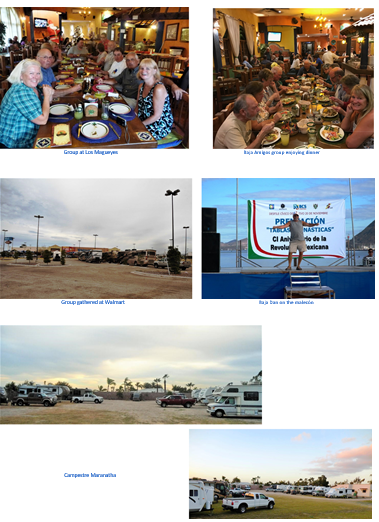 |
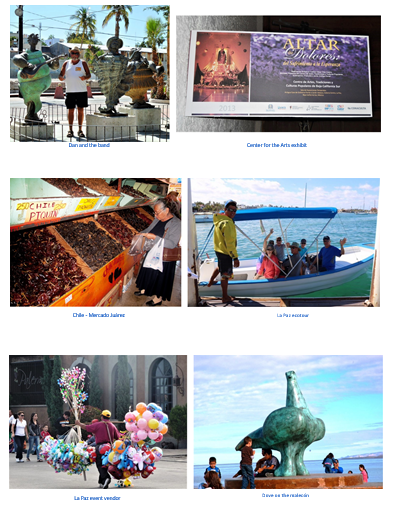 |
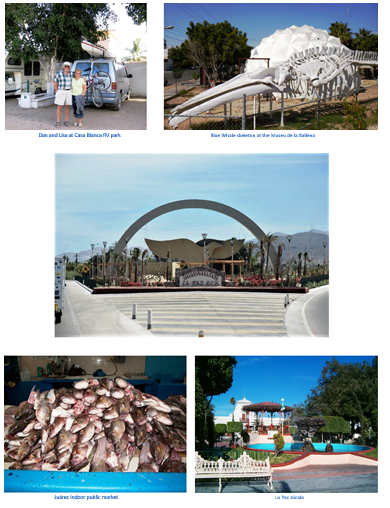 |
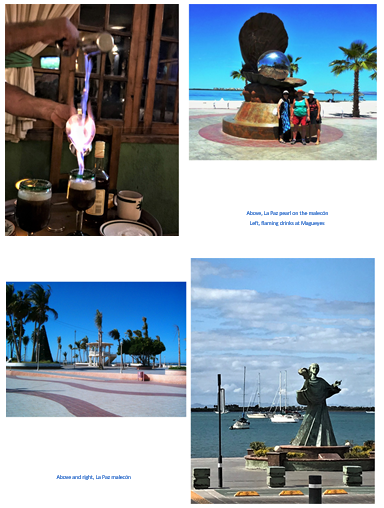 |
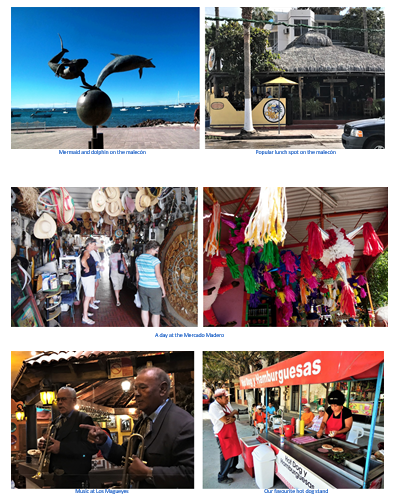 |
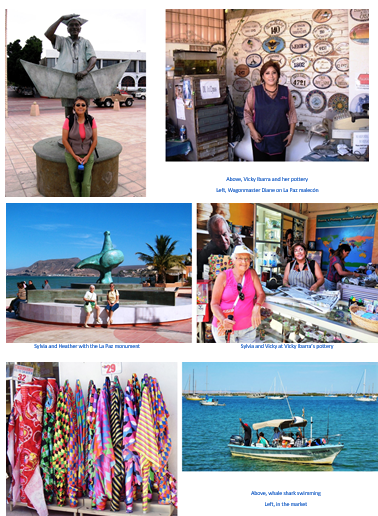 |
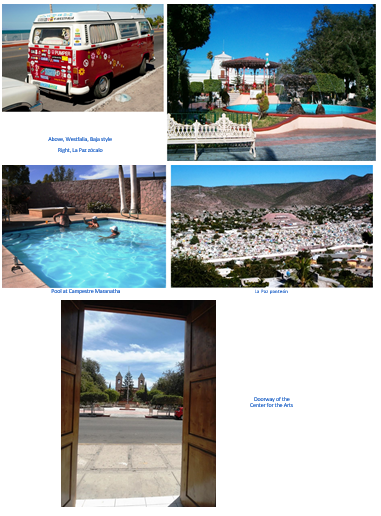 |
Dan and Lisa Goy, owners of Baja Amigos RV Caravan Tours, have been making Mexico their second home for more than 30 years and love to introduce Mexico to newcomers.
